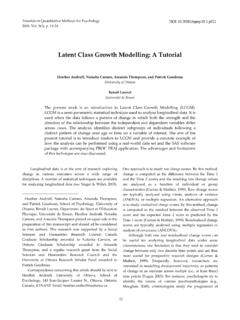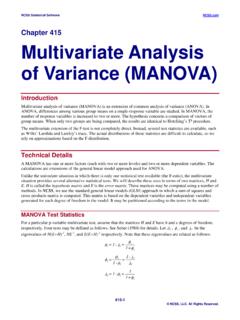Transcription of The GLM Procedure - SAS
1 SAS/STAT User's Guide The GLM Procedure This document is an individual chapter from SAS/STAT User's Guide. The correct bibliographic citation for the complete manual is as follows: SAS Institute Inc. 2013. SAS/STAT User's Guide. Cary, NC: SAS Institute Inc. Copyright 2013, SAS Institute Inc., Cary, NC, USA. All rights reserved. Produced in the United States of America. For a hard-copy book: No part of this publication may be reproduced, stored in a retrieval system, or transmitted, in any form or by any means, electronic, mechanical, photocopying, or otherwise, without the prior written permission of the publisher, SAS Institute Inc. For a web download or e-book: Your use of this publication shall be governed by the terms established by the vendor at the time you acquire this publication.
2 The scanning, uploading, and distribution of this book via the Internet or any other means without the permission of the publisher is illegal and punishable by law. Please purchase only authorized electronic editions and do not participate in or encourage electronic piracy of copyrighted materials. Your support of others' rights is appreciated. Government License Rights; Restricted Rights: The Software and its documentation is commercial computer software developed at private expense and is provided with RESTRICTED RIGHTS to the United States Government. Use, duplication or disclosure of the Software by the United States Government is subject to the license terms of this Agreement pursuant to, as applicable, FAR , DFAR (a), DFAR (a) and DFAR and, to the extent required under federal law, the minimum restricted rights as set out in FAR (DEC 2007).
3 If FAR is applicable, this provision serves as notice under clause (c) thereof and no other notice is required to be affixed to the Software or documentation. The Government's rights in Software and documentation shall be only those set forth in this Agreement. SAS Institute Inc., SAS Campus Drive, Cary, North Carolina 27513-2414. December 2013. SAS provides a complete selection of books and electronic products to help customers use SAS software to its fullest potential. For more information about our offerings, visit or call 1-800-727-3228. SAS and all other SAS Institute Inc. product or service names are registered trademarks or trademarks of SAS Institute Inc. in the USA and other countries. indicates USA registration. Other brand and product names are trademarks of their respective companies.
4 Gain Greater Insight into Your SAS Software with SAS Books.. Discover all that you need on your journey to knowledge and empowerment. for additional books and resources. SAS and all other SAS Institute Inc. product or service names are registered trademarks or trademarks of SAS Institute Inc. in the USA and other countries. indicates USA registration. Other brand and product names are trademarks of their respective companies. 2013 SAS Institute Inc. All rights reserved. Chapter 44. The GLM Procedure Contents Overview: GLM Procedure .. 3434. proc glm Features .. 3435. proc glm Contrasted with Other SAS Procedures .. 3436. Getting Started: GLM Procedure .. 3437. proc glm for Unbalanced ANOVA .. 3437. proc glm for Quadratic Least Squares Regression.
5 3440. Syntax: GLM Procedure .. 3446. proc glm Statement .. 3448. ABSORB Statement .. 3454. BY Statement .. 3455. CLASS Statement .. 3455. CODE Statement .. 3457. CONTRAST Statement .. 3457. ESTIMATE Statement .. 3459. FREQ Statement .. 3460. ID Statement .. 3461. LSMEANS Statement .. 3461. MANOVA Statement .. 3470. MEANS Statement .. 3474. MODEL Statement .. 3480. OUTPUT Statement .. 3484. RANDOM Statement .. 3487. REPEATED Statement .. 3488. STORE Statement .. 3492. TEST Statement .. 3493. WEIGHT Statement .. 3494. Details: GLM Procedure .. 3494. Statistical Assumptions for Using proc glm .. 3494. Specification of Effects .. 3495. Using proc glm Interactively .. 3497. Parameterization of proc glm Models .. 3498. Hypothesis Testing in proc glm .
6 3502. Effect Size Measures for F Tests in GLM .. 3508. Absorption .. 3513. Specification of ESTIMATE Expressions .. 3515. Comparing Groups .. 3517. 3434 F Chapter 44: The GLM Procedure Means versus LS-Means .. 3517. Multiple Comparisons .. 3519. Simple Effects .. 3530. Homogeneity of variance in One-Way Models .. 3532. Weighted Means .. 3533. Construction of Least Squares Means .. 3533. multivariate analysis of variance .. 3536. Repeated Measures analysis of variance .. 3537. Random-Effects analysis .. 3545. Missing Values .. 3549. Computational Resources .. 3549. Computational Method .. 3552. Output Data Sets .. 3552. Displayed Output .. 3554. ODS Table Names .. 3555. ODS Graphics .. 3558. Examples: GLM Procedure .. 3560. Example : Randomized Complete Blocks with Means Comparisons and Contrasts 3560.
7 Example : Regression with Mileage Data .. 3565. Example : Unbalanced ANOVA for Two-Way Design with Interaction .. 3569. Example : analysis of Covariance .. 3574. Example : Three-Way analysis of variance with Contrasts .. 3581. Example : multivariate analysis of variance .. 3585. Example : Repeated Measures analysis of variance .. 3593. Example : Mixed Model analysis of variance with the RANDOM Statement .. 3598. Example : Analyzing a Doubly multivariate Repeated Measures Design .. 3602. Example : Testing for Equal Group Variances .. 3607. Example : analysis of a Screening Design .. 3612. References .. 3617. Overview: GLM Procedure The GLM Procedure uses the method of least squares to fit general linear models. Among the statistical methods available in proc glm are regression, analysis of variance , analysis of covariance, multivariate analysis of variance , and partial correlation.
8 proc glm analyzes data within the framework of general linear models. proc glm handles models relating one or several continuous dependent variables to one or several independent variables. The inde- pendent variables can be either classification variables, which divide the observations into discrete groups, or continuous variables. Thus, the GLM Procedure can be used for many different analyses, including the following: simple regression proc glm Features F 3435. multiple regression analysis of variance (ANOVA), especially for unbalanced data analysis of covariance response surface models weighted regression polynomial regression partial correlation multivariate analysis of variance (MANOVA). repeated measures analysis of variance proc glm Features The following list summarizes the features in proc glm : proc glm enables you to specify any degree of interaction (crossed effects) and nested effects.
9 It also provides for polynomial, continuous-by-class, and continuous-nesting-class effects. Through the concept of estimability, the GLM Procedure can provide tests of hypotheses for the effects of a linear model regardless of the number of missing cells or the extent of confounding. proc glm . displays the sum of squares (SS) associated with each hypothesis tested and, upon request, the form of the estimable functions employed in the test. proc glm can produce the general form of all estimable functions. The REPEATED statement enables you to specify effects in the model that represent repeated measure- ments on the same experimental unit for the same response, providing both univariate and multivariate tests of hypotheses. The RANDOM statement enables you to specify random effects in the model; expected mean squares are produced for each Type I, Type II, Type III, Type IV, and contrast mean square used in the analysis .
10 Upon request, F tests that use appropriate mean squares or linear combinations of mean squares as error terms are performed. The ESTIMATE statement enables you to specify an L vector for estimating a linear function of the parameters L . The CONTRAST statement enables you to specify a contrast vector or matrix for testing the hypothesis that L D 0. When specified, the contrasts are also incorporated into analyses that use the MANOVA. and REPEATED statements. The MANOVA statement enables you to specify both the hypothesis effects and the error effect to use for a multivariate analysis of variance . 3436 F Chapter 44: The GLM Procedure proc glm can create an output data set containing the input data set in addition to predicted values, residuals, and other diagnostic measures.













